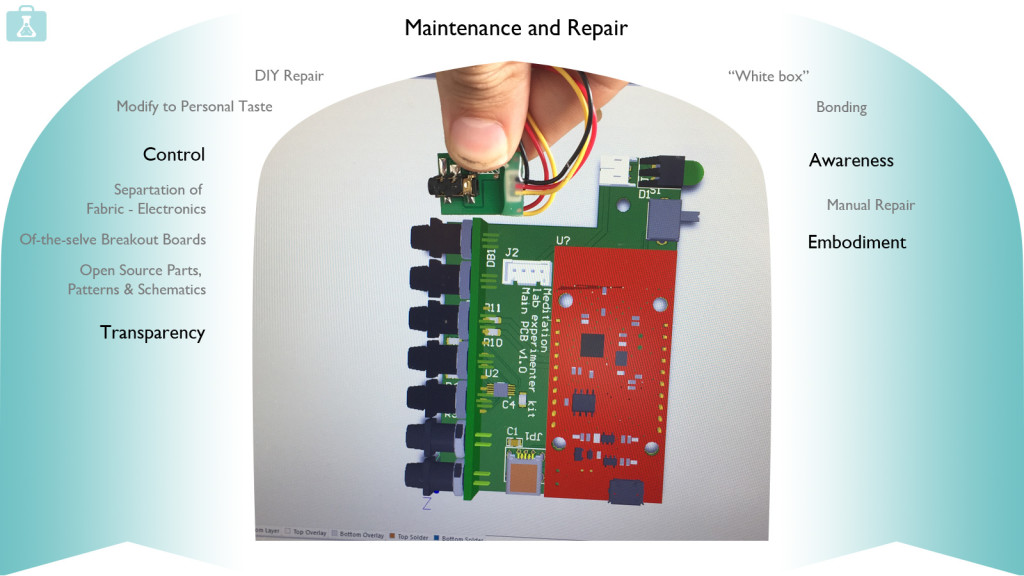This spring I wrote this article together with designer Vera de Pont. It was presented at the “Searching for the New Luxury” conference by the Fashion Colloquium. Unfortunately it will not be published in their journal. But we had a nice time writing it and we hope the content is of use to others.
Abstract
In this article the authors will explain the different, layered ways in which use of the wearable Silence Suit can be considered a new luxury. The main luxury is empowerment through giving awareness and control to the user supported by embodiment and transparency.
After explaining the system of which the wearable is part and the context from which the concept arose the life cycle of the wearable is used to explain how interacting with the suit offers many opportunities to experience a new sense of luxury.
Keywords: sustainability, meditation, open source, wearable technology, self-assembly, interaction design
Introduction
Experimenter kit
The wearable Silence Suit is part of Meditation Lab Experimenter Kit, a system which enables users to experiment with their meditation practice and improve it through insight and direct influence of the environment. With the wearable users can collect biometric and environmental data during the meditation session (Figure 1). The quality of the session is assessed using pre and post meditation questionnaires. Both data sets are fed into a learning system which determines which environmental variables have the most positive effect on the meditation quality. Through Internet of Things technology, the light in the environment is changed automatically depending on the meditation-quality predicted by the system.
This system is geared towards helping individual users improve their practice by giving them a toolset to conduct their own meditation experiments, get insight through exploring their data, and by actually optimising the environment for higher quality meditation.
Context
Danielle Roberts, artist/designer/innovator is the initiator and conceiver of the Kit. She has maintained an intensive meditation practice for over 20 years. She is also a self-tracking enthusiast and tracks health and lifestyle parameter on a daily basis. Both practices have shown her that increased awareness allows her to grow and flourish in a compassionate way. In her work she explores ways through which contemporary technologies can support this.
Roberts’s vision is to create the optimal home which will support a spiritual, productive, healthy and sustainable life: Hermitage 3.0. Being able to measure its’ inhabitant is the first step towards realising this holistic living environment.
Status and vision
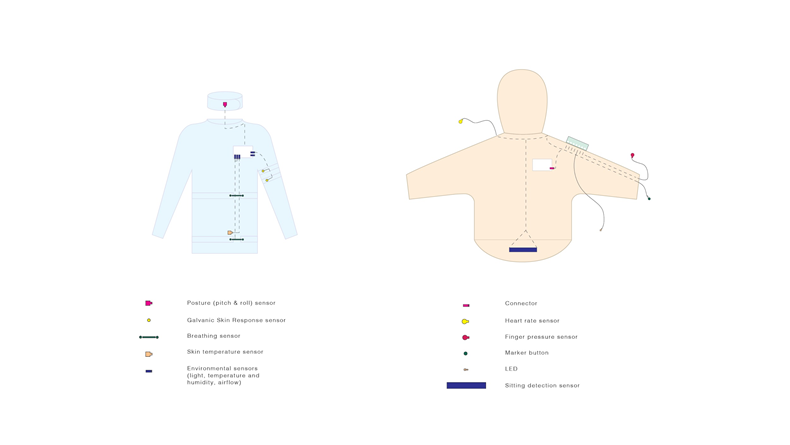
In 2015 Roberts started building the wearable Silence Suit. In 2017 the opportunity arose to apply with this first prototype for the WEAR Sustain open call[8]. This was issued by the European Commission to promote collaboration between creatives and technically skilled people to work on ethical and sustainable wearables. Roberts was one of the winners. Together with a team she designed and produced 5 wearables in 3 sizes and custom software was developed that allows users to create and analyse their own meditation experiments.
Design for agency
In recent years digital fabrication and specifically 3D printing and laser cutting as both creative and manufacturing tool has received much more widespread adoption. As enabling technology this facilitated a whole new range of self-assembly designs generated from digital files that are often presented as Open Source files to be customised and controlled by the end user.
The Silence Suit is designed with the Open Source philosophy in mind. The open approach to the garment’s production ensures a garment design that is accessible, manufacturable and upgradable by whoever chooses to do so[1] and makes it producible with a limited amount of machines in local workspaces and fablabs. Users become aware of the process of production and the parts of the suit.
With regards to the production of the Silence Suit, the aim is to develop a system where the level of end-user assembly is chosen by the end user themselves. Ranging from the level of complete individual production in local production facilities, to the level of end user assembly with pre-produced parts.
The transparency of self-assembly and the embodiment during local production constitute a new luxury which empower the user.
Silence Suit life cycle
At every stage of the life cycle the design and use of the system create for the user to experience the system properties embodiment and transparency. Which may produce control and awareness for the user. These properties and mind-sets interact and result in empowerment of the user. In this section this will be highlighted for every phase of the life cycle.
Prepare for use
The suit is designed for assembly and there are four possible user scenarios when preparing the suit for use:
A. Hard-core makers: Start from scratch and completely assemble and / or modify every aspect of the suit including the electronic parts.
B. Maker apprentice: Has some knowledge of the techniques involved but needs guidance in for example a workshop.
C. Meditator: Start from a semi-finished product. No soldering is required but the parts must be placed at the proper positions and connections.
D. Use a finished suit: no assembly, the user only has to put on the wearable. The design isn’t aimed at this type of use but it is imaginable in scenarios like meditation workshops or rental.
The following describes option C. This is how the parts were delivered to Roberts on first use.
To prepare the garment for use, it’s produced modular parts will have to be assembled. This includes the hardware pieces that have to be located on specific locations on the suit, as well as weaving the cables and attaching them to their respective hardware pieces.
To ensure a relatively short assembly time and correct end user assembly, the garment is designed as a manual for use. The suit contains engraved symbols which showcase the positioning of the sensor pieces. This helps the user to assemble the parts correctly while leaving the user free to weave the cables to her liking through small openings in the fabric. This tangible interaction with the suit can be a mindful action which aims to create a bond with the garment and raise awareness of all the parts that the suit contains.
Ease of use and perfect fit
The main prerequisites of the garment are its ease of use and comfortable fit. Here some opposing forces are at play:
| Many sensors | vs | Unobtrusiveness during meditation |
| Sensor placement | vs | Comfortable fit |
| Aesthetic style and cut | vs | Accurate and complete measurements |
| Putting on the garment correctly | vs | Mindfulness |
| Unobtrusive electronics | vs | Recyclability |
| Data collection | vs | Privacy and ethics |
The design process was aimed at solving these conflicting interests by carefully looking at the interaction between the user and the garment at various steps during use and stages of the life cycle.
The ‘perfect fit’ is relative to the way data can be optimally collected and the aesthetics of the garment is influenced by the way the garment will be used. For example the Galvanic Skin Response Sensor (Figure 2), which is positioned on the upper arm and needs direct contact with the skin for optimal data collection.
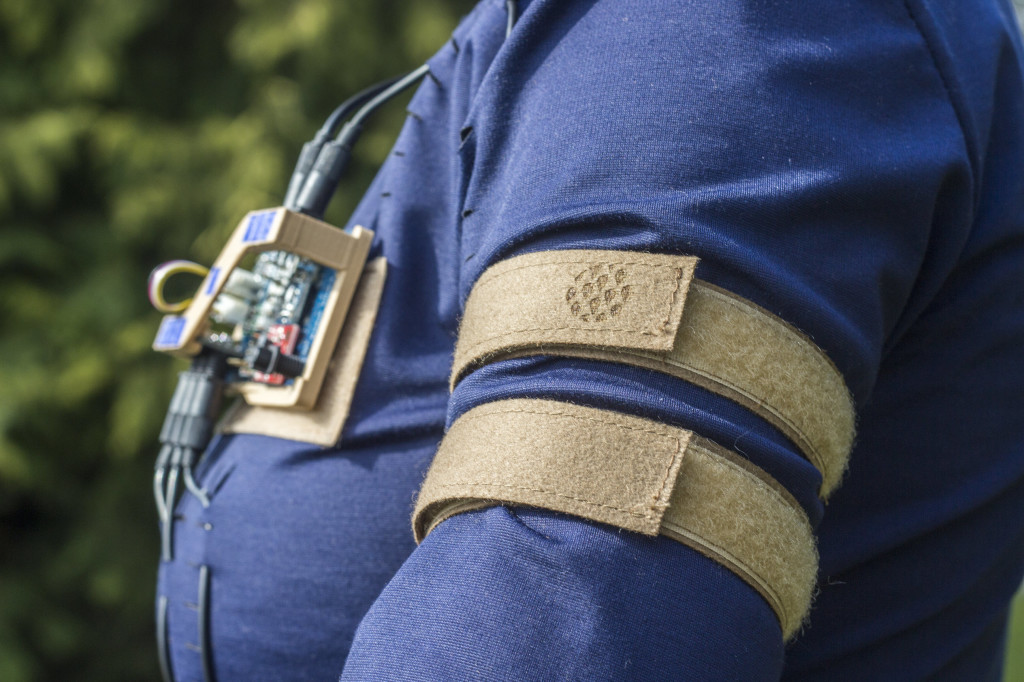
A conscious choice was made to develop the Silence Suit in 3 standardized unisex sizes (EU small/medium/large) to fit a multitude of people. Where tight fit is needed adjustable straps are provided for. These simple Velcro straps afford personalisation (Figure 3). The user can control the tightness for optimal balance between comfortableness and good measurements, as with the detachable neck piece carrying a posture sensor. The sensor is positioned within two layers of stretchable fabric, making sure that the placement is fixed and close to the skin without feeling stiff.
The tight fitting bottom layer feels soft to the skin, kindling awareness. It is complemented by a more loosely fitting top layer with a big hood that combines strength and flexibility to carry the hardware casings (Figure 4). The design choices give users control to personalise the fit of the suit.
Daily use
The main user group for Silence Suit is people who meditate regularly or daily. Using the suit daily should at a minimum be easy and as hassle free as possible. But in the design de Pont and Roberts looked for ways to go beyond that. Wearing the suit and interacting with the software should bring extra value and quality to the meditation practice and support awareness. The main focus areas for adding value and quality are:
- Smooth user interaction with the garment and the electronics
- Pleasing aesthetics and integration of special features which promote mindfulness and emotional bonding
- Empowering features embedded in the kits’ software
These focus areas are explained in detail below.
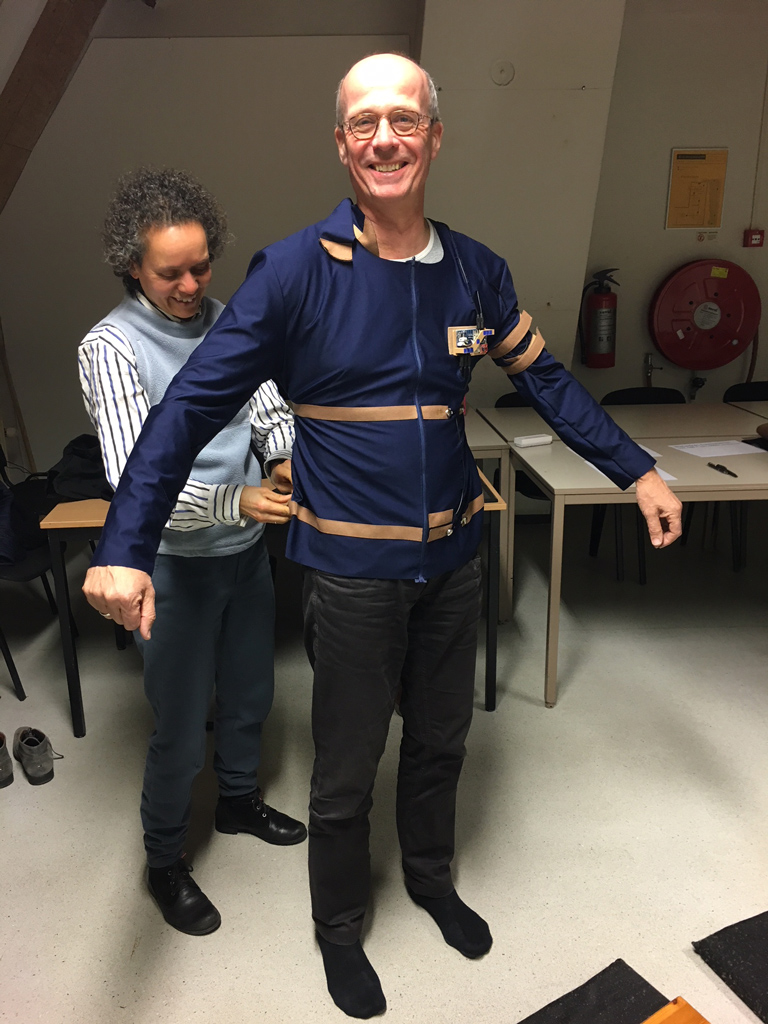
Awareness-promoting interaction with the wearable
Ideally doing meditation experiments with Silence Suit should contribute to and enhance awareness and mindfulness. In designing the suit the designers wanted the putting on and taking off the wearable to become a rhythm of actions.
In total there are eleven sensors on the suit and one feedback LED. They have to be fasted correctly and stored safely after use. The design was tested extensively by Roberts during her daily meditation practice and a six day retreat. During group experiments almost 40 different users tested the design.
Feedback from users indicated that if all the sensors are fastened correctly the electronics have no negative influence on the meditation experience, people are not aware that they are being measured by 11 sensors.
The way the sensors and fasteners are positioned facilitates the ritualization of the interaction with the garment. The attention needed to secure the sensors primes for attention during the session. Exclamations after the experiments like “Wow, this suit is so comfortable” were no exception.
Enrichment of meditation practice through special features
Users found the aesthetics pleasing this contributed to the enjoyment of the meditation experience. The design also includes special features to further support awareness and control during meditation:
- An oversized hood inspired on the cowl of a monks’ habit. It was used frequently by Roberts and the experiment participants. In a practical sense it shields from cold while sitting still. But it also creates intimacy which makes it easier to withdraw and block out distractions. Both Roberts and the participants have used the hood for these purposes.
- On the top layer there is a vertical row of seven incisions. A small flap can be inserted into these slits creating an opening in the garment. This provides an analogue and transparent way to track daily sessions. Thus the practice is made visible and tangible which can be motivating. These interactions may also create an extra bond with the garment, making it more personal.
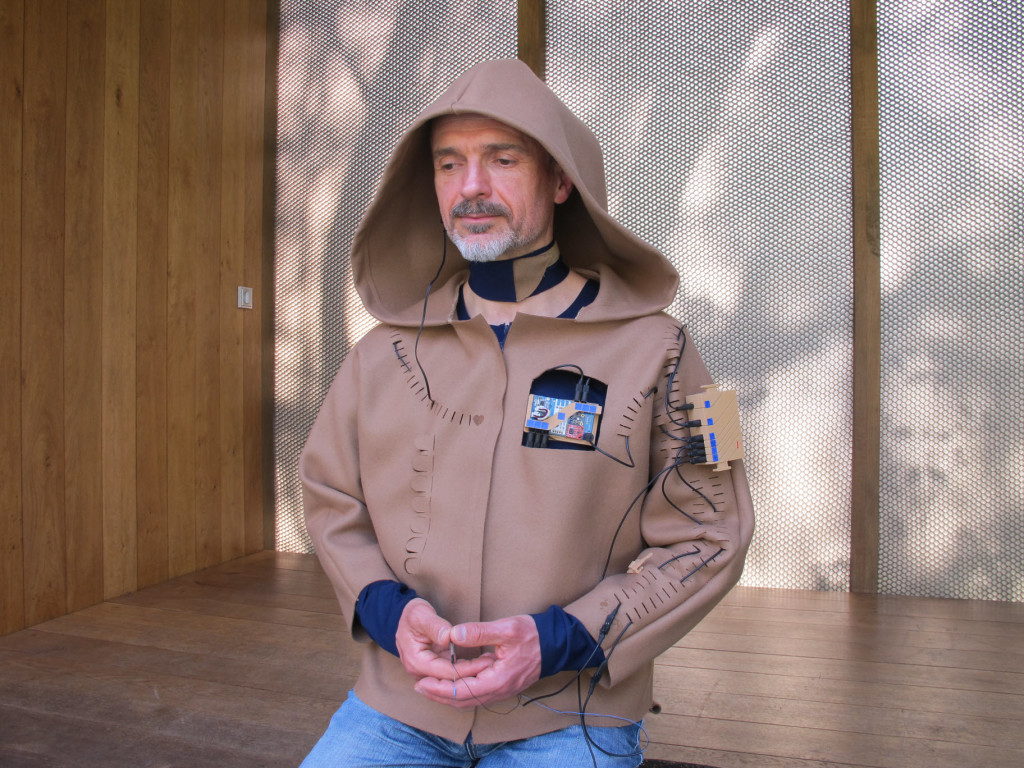
Introducing the Dataserver
With the wearable comes a custom software application, the Dataserver (Figure 5).
The functionality of the software is based on enabling users to experiment with their own meditation practice. The hypothesis underlying the functionality is that the environment in which one meditates has an impact on the quality of the meditation session. Changing the environment may impact the meditation quality in a positive way. The current version of the Dataserver supports experimenting with environmental light. Three light conditions are offered to experiment with. Research in other domains has shown that these conditions can respectively impact concentration[6], alertness[7] or relaxation[4].
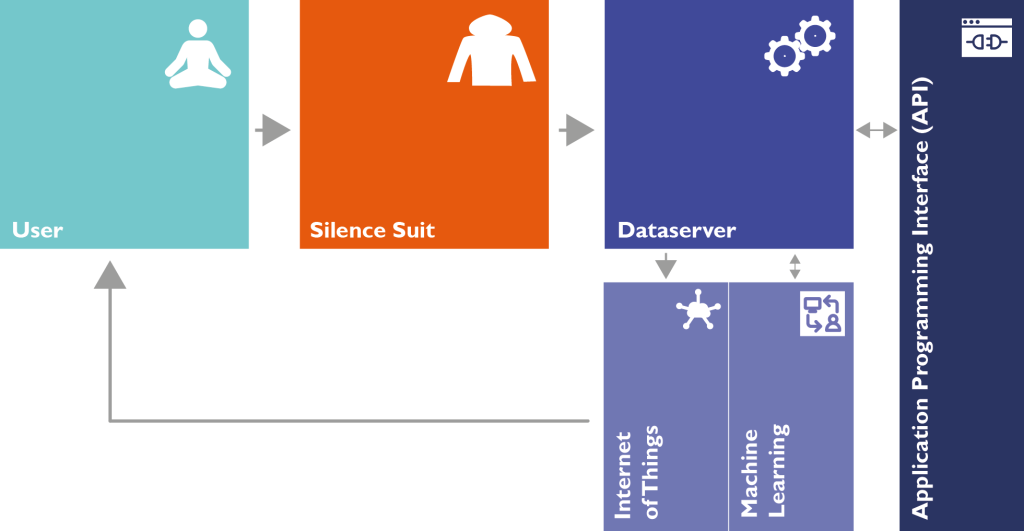
With the system users can log, view and compare data, conduct single and group experiments using the three light settings. Meditation quality is determined by pre and post meditation questionnaires. The quality outcomes are used in a machine learning algorithm. Once the system is trained it will automatically change the environmental light based on predictions of meditation quality.
Software: empowering users by creating awareness and control
The software aims to quantify meditation in order to create awareness and insight. It gives the results back to the users in two ways:
- In the form of graphs after a meditation session. In this sense the software is used as a quantified-self tool. Self-tracking has been shown not only to give trackers awareness of and insight into the workings of their body it also gives the sense of being able to transform their bodies[1]. The meditation kit creates awareness of the body through biometric data. Filling in pre and post meditation questionnaires makes the user aware of subjective mind states connected to meditation thus empowering users to also experience more control of and insights into the workings of their minds. This can motivate users to practice.
- In the form of an embodied experience during meditation based on real-time data. In this case the software transforms the actual meditation experience by predicting the most optimal light conditions throughout the session. This may lead to improved relaxation, concentration and alertness during the sessions.
Quantification can bring with it the risk of loss of privacy and agency[9, 5]. The software tries to minimise these risks in the following ways:
- Control over and ownership of personal data. This is ensured because the system is designed to work offline and function fully on the users’ own PC. No data is send over the internet, data is stored locally
- Data literacy: Users get insight into their personal data through graphs and basic statistics
- Science literacy: The software provides easy steps to design and conduct experiments
Maintenance and repair supported by transparency and control
In the above is explained how the design uses size, fit and style to enhance longevity through awareness and control. Care is one of the fundamental areas mentioned in the WRAP Design for Longevity report[2] in promoting the lifespan of a garment. Easy replacement and repair was one of the guiding principles to support the durability of the design. This has been approached in different ways which are outlined below.
Modularity
The life-cycle of electronics is often much different than the usage patterns of fashion wearables. Therefore modular self-assembly is used in the design of the Silence Suit as enabling technology in the integration of on-body sensors in textiles. Where-as fashion items are worn and go out of use depending on fashion trends or personal aesthetics, the life cycles of electronic wearables depend on limitations like battery life and upgrade cycles of the technology. To elongate the lifespan of the Silence Suit and make electronic replacements simple, the design approached sustainability in two ways. One on the level of the suit’s infrastructure and one on the level of the electronic parts:
Level 1: By clearly separating the electronic parts from the garment, instead of integrating them, the design approaches sustainability through transparency. This “white box” approach makes the electronic infrastructure visible and easily accessible. This creates awareness.
Level 2: Instead of working towards miniaturisation and using unique custom parts, the design uses the ready made breakout boards and leaves them mostly intact. The entire board can be removed and replaced in one action. Most of the electronic parts and sensors are low cost, off-the-shelf Open Source components which can be bought from online electronics shop.
These two approaches on different levels aim to facilitate user control to increase the lifespan of the suit.
Customisation
Access and modification of the production files is a transparent approach which allows for custom modification during the lifecycle of the suit. Once the patterns become available users can control the outcome of the suit. They can make the suit locally to their own taste and even modify the files to make a personal, tailored version.
These customizations can be done by the user herself. Embodied actions may strengthen the bond with the wearable making it more and more personal over time.
The flexibility of the wearable is also reflected in the software approach. The system architecture is designed to be scalable: users, suits and actuators can be added to the system without breaking it.
Software flexibility is also expressed by providing an API. This allows users to control the output and to build custom applications using their own data and extend the use of the platform.
End of life
Material choices for the Silence Suit were made with recyclability and carbon neutrality in mind. The top layer is 100% wool, one of the most sustainable textiles[3]. When exposed to moisture, the fibre will gradually decompose.
The chosen material of the bottom layer is a mixed Modal fabric. Modal has been made from a renewable crop and is biodegradable.Laser cutting requires special properties of the textile. At this point in time no more sustainable fabric options were available therefor a mixed fabric was chosen which is not fully biodegradable. Up to date fabric recommendations will be accompanying the digital production files allowing users to choose the most sustainable options available.
3D printed casings and cable connectors were printed with a PLA filament. This carbon neutral filament is plant based and biodegradable. It can also be recycled with a plastic recycling machine which can even produce a new filament to start with.
The modularity and transparency of the suit design facilitate responsible actions at the end of the life cycle, this may be considered a new luxury in the realm of wearable fashion. Textiles and electronics are often merged in order to obscure the technology and render it unobtrusive. However, in this design, users can manually separate the fabric from the electronics without any special tools or equipment and recycle the parts locally.
The systems’ transparency and ease of disassembly removes barriers for users to dispose of the suit. The “intestines” of the suit are laid bare. This creates awareness of what the suit is and how it is put together.
Visions for the future
In the previous part it is explained how embodiment and transparency drive awareness and control in the present prototype. Future plans and applications are geared to further strengthen these qualities.
New paths to awareness
Future research will focus on stimulating more senses to enhance embodiment. Apart from light influence research will extend to other senses and actuators, for example room temperature and airflow. Roberts is designing immersive meditation experiences from live meditation data. She is working on tele-meditation and meditation performances which will provide novel paths to user awareness.
Multi-sense actuation and immersion will provide more ways to experience body awareness.
More control with an Open Source product
The five suits available now are not ready for market. The plan is to sell the design as a physical kit, reminiscent of the various experimenters’ kits available from open source online vendors. Ideally users can purchase the kit in different stages of completion corresponding to the scenarios outlined above.
Future developments will be aimed at making the digital blueprints accessible and transparent for specific user groups, so that users can enter the production of the Silence Suit at the level most suitable to them.
To improve assembly time and make production more efficient for all user types, further developments will also be aimed at implementing 3D printed connectors to eliminate any sewing activities. Parts can be upgraded, updated and reused and eventually more easily recycled when no longer needed.
Open source schematics and code allow for user-driven upgrades and customisations.
Once the API to the Dataserver is published programmers can start building their own applications on top of the system giving them ultimate control over its use and outcomes.
Creating connections
All of the future plans will, to a more or less extend contribute to the possibility to create a community around the project. While using the kit an individual user may experience awareness, control, transparency and embodiment. Interaction between these factors can result in new ways of connection between different users:
- Experiment together: because of the research component embedded in the system users can connect by conducting experiments together. This feature is already provided.
- Community platform: the plan is to create an online community platform were users and makers can exchange experiences, knowledge, ideas and parts or redundant suits. This can help to move towards circularity.
- New ways of connection through technology: as explained above Roberts is working on novel ways of sharing meditation data and creating new, shareable content and experiences from it such as performances.
- App creation: makers will be encouraged to share their new applications and code with others.
Discussion
The findings with regard to user experience are mostly from one source, Roberts. At this point she has used the system most frequently. On the one hand this provides a profound knowledge about the interaction with the suit on the other hand these insights are limited to only one user who is also the maker and therefore has prior knowledge of and perhaps a positive bias towards the wearable. The wearable was to some extend made to measure for Roberts which might also give her an advantage when it comes to judging the fit of the garment. However participants of the experiments did not contradict Roberts’s findings. More intensive individual experiment tracks are planned which will yield more insight into user satisfaction during frequent use.
New experiments also will give more insight into the effectiveness of the meditation actuation through light. Findings from one user are not enough to determine if environmental light has a positive effect on meditation quality.
Meditation Lab Experimenter Kit has from the start been conceived as a springboard for applications which will make use of the kit. This becomes apparent in for example the provided API and the digital blueprints. So even though the future plans may seem speculative they have been part of the design from the start. What the effects of the proposed new applications will be is part of the design and research process that will inform these new designs. The authors wanted to extend the findings of current design to the future perspective they foresee for the system precisely because user control and adjustability is an essential part of the new kind of luxury this design provides.
Conclusions
Throughout the lifecycle of the garment there are two empowering principles at play which constitute a new luxury: user control and user awareness. They are supported respectively by:
- System transparency in the form of: System modularity and local production, self-assembly and customisation by the user and open source philosophy.
- Elements of embodiment in using the system in the form of: ritualization of interaction, emotional bonding, embodied and tangible interaction, personalisation.
Emerging from interactions between these principles the system also allows for new kinds of connections, turning the individual act of meditation into something which can bring users together. This is true for the current prototype and will be build upon as the system ecology develops.
References
[1] Bergsland, R. (2017). The human/wearable technology engagement and its embodied effects on self-trackers. University of Gothenburg.
[2] Cooper, T. et al. (2013). Design for Longevity Final report, WRAP p. 16
[3] Ryan, R. (2016). The Fashion English Bible. Vaughan, p 265-266.
[4] Seuntiens, P.J.H. & Vogels, I. (2008). Atmosphere creation: The relation between atmosphere and light characteristics. Proceedings from the 6th Conference on Design and Emotion 2008.
[5] Sharon, T. (2017). Self-Tracking for Health and the Quantified Self: Re-Articulating Autonomy, Solidarity, and Authenticity in an Age of Personalized Healthcare. Philosophy & Technology Volume 30, Issue 1, pp 93–121.
[6] Sleegers, P.J.C., Moolenaar, N.M., Galetzka, M., Pruyn, A., Sarroukh, B.E., van der Zande, B. (2013). Lighting affects students’ concentration positively: Findings from three Dutch studies. Lighting Research & Technology Vol 45, Issue 2, pp. 159 – 175
[7] Taillard, J., Capelli, A., Sagaspe, P., Anund A., Akerstedt T, Philip P (2012). In-Car Nocturnal Blue Light Exposure Improves Motorway Driving: A Randomized Controlled Trial. PLoS ONE 7(10): e46750.
[8] WEARsustain. (2017). Open Call Themes for Project Proposals. Accessed 23-5-2018 https://wearsustain.eu/open-calls/open-call-themes/
[9] Zhou, Wei & Piramuthu, Selwyn. (2014). Security/privacy of wearable fitness tracking IoT devices. Iberian Conference on Information Systems and Technologies, CISTI. 1-5. 10.1109/CISTI.2014.6877073.
[1] The same counts for the software systems, which the user can control completely and also build upon. View also “Maintenance and repair supported by transparency and control”.
